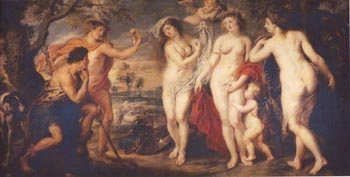| Search Art Prints | ||||||||||||||||||||
| Search Artists | ||||||||||||||||||||

|
||||||||||||||||||||
|
|
|||||||||||||||||||

The Judgment of Paris

|
The Judgement of Paris
A master of the Baroque, Peter Paul Rubens was perhaps the most famous European painter of his time. By 1610, Rubens' work was in such high demand that he relied on his apprentices to paint many of his commissions for him. This shrewd production method allowed Rubens to devote himself to projects he was especially impassioned about .One such project was The Judgment of Paris, a piece commissioned by no one less than King Philip IV of Spain. This 1635 undertaking marks the fourth time Rubens would illustrate a scene from the same-titled Greek myth.
In the story of the judgment of Paris, the wicked goddess Eris is enraged when she is not invited to a banquet held by Zeus. She enacts her revenge by tossing a golden apple into the festivities. The apple's inscription: "to the fairest." This creates a major uproar among the gathered immortals. Hera, Aphrodite and Athena all claim ownership of the apple, however only one of them can rightfully be called the most beautiful. To resolve this dilemma, Zeus calls upon Hermes to bring the three goddesses to Prince Paris of Troy, a mortal renowned for his fairness. Upon appearing before Paris on Mount Ida, the goddesses each try to tempt him with incredible gifts. Naturally, the prince soon finds his objectivity pushed to its limit, as the gifts become more and more extravagant.
It should come as no surprise why Rubens was fascinated by the myth of Paris. A lover of the female form, the artist famously lent his name to the term "Rubenesque." His devotion to his nudes was such that when King Philip's brother suggested he do more to veil his figures, Rubens refused. Indeed, the goddesses in his Judgment of Paris are among the most voluptuous figures in his oeuvre. While the painting shows Paris awarding Aphrodite the golden apple, Rubens subtly suggests the folly of his decision by making all three goddesses equally radiant.
Analysis and Reviews
As a painter of nudes, Rubens is arguably the most renowned of all time. His brilliant use of light and color was virtually unrivalled during his lifetime. Art historian Roger Avermaete said of Rubens, “no painter has ever painted flesh whiter and at the same time more vibrant with life, and no artist had ever glorified flesh so eloquently.”
The Judgment of Paris is currently located at the National Gallery in London.











